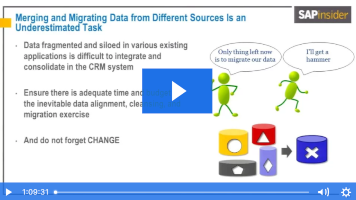Techniques to Optimize Marketing Lead Management and Key Account Management Processes within SAP CRM
Q&A with Dr. Ahmed Hezzah
In sales, key account managers often struggle when trying to manage their key accounts and end up adapting standard sales functionality of SAP CRM to efficiently support their very individual needs for navigation, authorization, and reporting of their key account hierarchy.
By understanding those challenges and following a comprehensive step-by-step approach, you can implement a key account management solution for your global organization that supports the specifics of your key account management process while still taking advantage of the various sales features already available in SAP CRM.
In this live Q&A with Customer Engagement & Commerce 2017 speaker Dr. Ahmed Hezzah, answered marketing and sales questions on implementing effective campaign execution and lead generation processes across marketing and sales within SAP CRM to identify and close more sales opportunities, enhance key account processes, and support lead qualification and routing processes.
Meet the panelist:
 Dr. Ahmed Hezzah, Accenture
Dr. Ahmed Hezzah, Accenture
Dr. Ahmed Hezzah, is a Senior Manager at Accenture with deep experience in SAP and CRM project management and solution architecture. He has a strong focus on marketing, sales, and analytics, as well as deep expertise in cloud integration, testing, deployment, migration, and managed delivery. In the last 15 years, he has been managing large and complex SAP implementations and global rollouts for a number of clients across industries and has gained a long history of experience with utilizing onshore and offshore delivery models. Ahmed holds a PhD in computer science, a PMP certification, and an SAP certification in SAP CRM and C4C.
Mr. E. Emery: Welcome to today’s live Q&A on techniques to optimize marketing lead management and key account management processes within SAP CRM. I am very pleased to have Customer Engagement & Commerce 2017 speaker Dr. Ahmed Hezzah of Accenture joining us!
Dr. Ahmed Hezzah has presented at a number of SAPinsider Customer Engagement & Commerce events. He is a Senior Manager at Accenture with deep experience in SAP and CRM project management and solution architecture. We are delighted to be seeing him in Orlando next month!
Dr. Hezzah, thanks for being here today and answering questions on overcoming specific challenges in sales and marketing utilizing key processes and integration techniques, and SAP CRM!
Ahmed Hezzah: Thanks for the introduction, Emile. Welcome everybody to this Q&A session. I’m going through the question and will try to answer them all.
Comment From Josh: What do you recommend is the best way to manage pipelines and structure key account master projects?
Ahmed Hezzah: Using Opportunities to structure your projects and create “master projects” will help you. For instance, if you created an opportunity centrally in the headquarters and then passed it to different local sites for follow-up. You could do this by linking all “sub-projects” to the “master project” which also allows for easier navigation, but requires some development work.
Comment From Brendan: We are having some difficulty managing authorizations. What CRM functionality do you recommend as the best way to manage these and do you have any specific configuration recommendations for the account hierarchy?
Ahmed Hezzah: In addition to the classic authorization capabilities, SAP CRM offers a powerful Access Control Engine (ACE). This allows for combining different roles and defines exactly which data can be processed by a certain role, not just which activities can be performed. Using the account hierarchy as the basis for the role definition makes it possible to define certain access rights for different accounts, regions or countries. However, ACE is a complex tool that requires special skills and additional time-consuming activities during development and testing.
Comment From Haley: What steps should we take when mapping our existing processes to ensure a smooth go-live?
Ahmed Hezzah: I would start by describing day-in-a-life scenarios and identify relevant use cases. Therefore, it is essential to involve both marketing and sales in the process definition from the very beginning, and ideally have a process owner for each process to ensure a common understanding and a harmonized process definition. It is also critical to understand which criteria are important to sales for the leads they expect and consider them in the lead qualification and scoring process to avoid generating irrelevant leads. But it needs to be understood that some changes will come to current process in exchange of having one common approach.
Comment From Erica: We are evaluating Marketo for marketing automation. Do you have any advice on integration with SAP CRM?
Ahmed Hezzah: When integration Marketo or any other marketing automation tool, it is very important to keep it simple; i.e. use the tool as it is supposed to be used and do not try to make too many changes to the standard solution. After all, it is in most cases a cloud solution shared between multiple customers, so changes could be difficult sometimes. Also, do not try to cover the entire marketing process in Marketo, but rather build the core processes in SAP CRM and exchange only the necessary data with Marketo for campaign execution and response capturing.
Comment From Guest: Is SAP CRM C4C Marketing having similar functionalities like Hybris Marketing
Ahmed Hezzah: Actually, C4C Marketing capabilities are very limited as most of the new developments are moving into Hybris Marketing.
Comment From Rich: How will SAP CRM evolve with Hybris and SAP S/4 HANA? Which aspect of S/4 takes over CRM? Will Hybris do it? Which one will take on the Customer Interaction Center?
Comment From kalyan atukuri: I am interested to see how SAP CRM is evolving into SAP Hybris
Ahmed Hezzah: The Hybris Marketing solution is growing and adding more and more functionality to cover the entire Marketing process. I expect SAP CRM to become more or less a master data holder while almost all the transactional activities will be performed in Hybris Marketing, which is available on premise or as a Service and is based on S/4 HANA. The CIC will be supported by C4C in the future.
Comment From Chris: We would like to improve our lead routing to our sales team. In your experience, what suggestions do you have for automating this process within SAP CRM?
Ahmed Hezzah: It is easier if you generate and qualify Leads in SAP CRM, since this is a standard process. The challenges come when you have another tool for Lead generation and qualification as sometimes these tools will have a totally different definition of what a Lead is, so you will need to do some mapping first, then you will need to move the qualified Leads over to SAP CRM and process them further before routing to Sales. My suggestion would be to move only those Leads qualified as “hot” to SAP CRM, create standard Lead objects in SAP CRM and define rules for Lead distribution within SAP CRM to have this process automated.
Comment From Brian: How can SAP CRM standard sales functionality be leveraged to handle the challenges of key account management?
Ahmed Hezzah: If you will be attending the CEC 2017 conference, I will hold an entire session just to answer this question, otherwise feel free to email me if you have a specific issue. Start by understanding the individual needs of your key account managers that cannot be covered by standard SAP CRM functionality. Then you can use the Account Hierarchy to build a dedicated hierarchy for KAM as the basis for search and navigation through your key accounts, but also for authorization and reporting purposes.
Comment From Chandan: I am keen to hear the end to end process.
Ahmed Hezzah: It is indeed very important to have a clear definition for the end-to-end process, but also to have a common understanding between Marketing and Sales on Lead identification and qualification based on common criteria. This would improve the visibility of Campaign and Lead management activities, but also the tracking and reporting of Campaign success. If you use a separate tool for Campaign execution, we typically recommend that Campaign Planning and Segmentation remains within CRM and that you exchange Marketing Prospect data with the execution tool, which then sends the qualified Leads back to SAP CRM as Sales Prospect for further follow up by the Sales team. I will also be holding a session on that at the CEC 2017 conference if you will be there.
Comment From Nick: How can the entire marketing and sales process be covered across different tools to achieve an effective lead qualification and unified tracking and reporting of campaign success?
Ahmed Hezzah: Please also see my previous answer. In addition to that, using a dedicated Marketing Automation tool on top of SAP CRM could reduce the need for an external agency if you are using one. Integrating such a tool with SAP CRM allows for the automated execution of Marketing Campaigns and feeding the responses back to CRM to plan further activities and routing to Sales.
Comment From Kirsten: What are some things to be mindful of when integrating SAP CRM with a native SAP or even a 3rd party cloud solution for our marketing? We are trying to anticipate some pain points.
Ahmed Hezzah: First, understand that these cloud solution although very innovative still have some technical limitations, so do not try to implement too many process steps in that tool and do not open the door for too many changes. Second, stick to the standard. Keep the core Marketing processes like Campaign planning and development in SAP CRM. Do a data mapping exercise and use the provided interfaces of that tool to integrate it with SAP CRM. Beware that this integration can sometimes be more complex than you would expect and is not always easy to do in parallel to the solution implementation.
Comment From Johannes: What sort of process can be implemented to strengthen our lead qualifications and help us track how well our campaigns our doing?
Ahmed Hezzah: It is best to base Lead qualification on pre-defined criteria aligned with your Sales team. The last thing you want to do is generating irrelevant Leads that Sales will either ignore or send you back. Based on these criteria, you need to define a solid scoring and nurturing approach to ensure that you are only routing relevant Leads to Sales. Through the integration of Lead and Opportunity Management, both in SAP CRM or in different tools, you can track what happens with the qualified Leads and how many Opportunities were generated through each channel to measure your Campaign success and define further activities.
Comment From Jeff: What are your thoughts on using SAP Hybris Cloud for Customer to replace SAP CRM to improve sales teams visibility into its customers? Or can a comparable level of insight be gained with SAP CRM’s current capabilities?
Ahmed Hezzah: As most of the newest developments are made in C4C, I would say that it is becoming the future-oriented solution of both. Maybe some capabilities are comparable today, but this will be different in a few months and years as C4C will be developed at a higher pace and will offer more innovative features much faster and cheaper than SAP CRM.
Comment From Jehangir Shaik: Dr. Ahmed, thanks for organizing this discussion. Would it be feasible for SAP to extend territory management to Rules-Based Lead Distribution repository actions (even though territory-based checks can be enabled at the transaction level, particularly at the sales order)?
Ahmed Hezzah: Generally speaking, there would be different ways for rule-based lead distribution, one of them could be based on an enhanced territory management model as you mentioned. In my view, this should first be defined on a business level to come up with a clear approach for Lead distribution from Marketing to Sales, which could vary between organizations and therefore a few adjustments to the standard capabilities might still be required.
Ahmed Hezzah: Thank you everyone for attending today’s session. It was a pleasure having this very interesting conversation with you, and I hope to see some of you soon at the CEC 2017 conference in Orlando. If you have any further questions, feel free to email me at ahmed.hezzah@accenture.com. You can also follow me on Twitter @HezzahAhmed for further insights and updates. Have a good day.
Mr. E. Emery: I would like to thank Dr. Ahmed Hezzah for all your insightful answers and everyone who participated in the today’s chat. I hope to see you at our upcoming Customer Engagement & Commerce 2017 conference next month in Orlando, FL!
In sales, key account managers often struggle when trying to manage their key accounts and end up adapting standard sales functionality of SAP CRM to efficiently support their very individual needs for navigation, authorization, and reporting of their key account hierarchy.
By understanding those challenges and following a comprehensive step-by-step approach, you can implement a key account management solution for your global organization that supports the specifics of your key account management process while still taking advantage of the various sales features already available in SAP CRM.
In this live Q&A with Customer Engagement & Commerce 2017 speaker Dr. Ahmed Hezzah, answered marketing and sales questions on implementing effective campaign execution and lead generation processes across marketing and sales within SAP CRM to identify and close more sales opportunities, enhance key account processes, and support lead qualification and routing processes.
Meet the panelist:
 Dr. Ahmed Hezzah, Accenture
Dr. Ahmed Hezzah, Accenture
Dr. Ahmed Hezzah, is a Senior Manager at Accenture with deep experience in SAP and CRM project management and solution architecture. He has a strong focus on marketing, sales, and analytics, as well as deep expertise in cloud integration, testing, deployment, migration, and managed delivery. In the last 15 years, he has been managing large and complex SAP implementations and global rollouts for a number of clients across industries and has gained a long history of experience with utilizing onshore and offshore delivery models. Ahmed holds a PhD in computer science, a PMP certification, and an SAP certification in SAP CRM and C4C.
Mr. E. Emery: Welcome to today’s live Q&A on techniques to optimize marketing lead management and key account management processes within SAP CRM. I am very pleased to have Customer Engagement & Commerce 2017 speaker Dr. Ahmed Hezzah of Accenture joining us!
Dr. Ahmed Hezzah has presented at a number of SAPinsider Customer Engagement & Commerce events. He is a Senior Manager at Accenture with deep experience in SAP and CRM project management and solution architecture. We are delighted to be seeing him in Orlando next month!
Dr. Hezzah, thanks for being here today and answering questions on overcoming specific challenges in sales and marketing utilizing key processes and integration techniques, and SAP CRM!
Ahmed Hezzah: Thanks for the introduction, Emile. Welcome everybody to this Q&A session. I’m going through the question and will try to answer them all.
Comment From Josh: What do you recommend is the best way to manage pipelines and structure key account master projects?
Ahmed Hezzah: Using Opportunities to structure your projects and create “master projects” will help you. For instance, if you created an opportunity centrally in the headquarters and then passed it to different local sites for follow-up. You could do this by linking all “sub-projects” to the “master project” which also allows for easier navigation, but requires some development work.
Comment From Brendan: We are having some difficulty managing authorizations. What CRM functionality do you recommend as the best way to manage these and do you have any specific configuration recommendations for the account hierarchy?
Ahmed Hezzah: In addition to the classic authorization capabilities, SAP CRM offers a powerful Access Control Engine (ACE). This allows for combining different roles and defines exactly which data can be processed by a certain role, not just which activities can be performed. Using the account hierarchy as the basis for the role definition makes it possible to define certain access rights for different accounts, regions or countries. However, ACE is a complex tool that requires special skills and additional time-consuming activities during development and testing.
Comment From Haley: What steps should we take when mapping our existing processes to ensure a smooth go-live?
Ahmed Hezzah: I would start by describing day-in-a-life scenarios and identify relevant use cases. Therefore, it is essential to involve both marketing and sales in the process definition from the very beginning, and ideally have a process owner for each process to ensure a common understanding and a harmonized process definition. It is also critical to understand which criteria are important to sales for the leads they expect and consider them in the lead qualification and scoring process to avoid generating irrelevant leads. But it needs to be understood that some changes will come to current process in exchange of having one common approach.
Comment From Erica: We are evaluating Marketo for marketing automation. Do you have any advice on integration with SAP CRM?
Ahmed Hezzah: When integration Marketo or any other marketing automation tool, it is very important to keep it simple; i.e. use the tool as it is supposed to be used and do not try to make too many changes to the standard solution. After all, it is in most cases a cloud solution shared between multiple customers, so changes could be difficult sometimes. Also, do not try to cover the entire marketing process in Marketo, but rather build the core processes in SAP CRM and exchange only the necessary data with Marketo for campaign execution and response capturing.
Comment From Guest: Is SAP CRM C4C Marketing having similar functionalities like Hybris Marketing
Ahmed Hezzah: Actually, C4C Marketing capabilities are very limited as most of the new developments are moving into Hybris Marketing.
Comment From Rich: How will SAP CRM evolve with Hybris and SAP S/4 HANA? Which aspect of S/4 takes over CRM? Will Hybris do it? Which one will take on the Customer Interaction Center?
Comment From kalyan atukuri: I am interested to see how SAP CRM is evolving into SAP Hybris
Ahmed Hezzah: The Hybris Marketing solution is growing and adding more and more functionality to cover the entire Marketing process. I expect SAP CRM to become more or less a master data holder while almost all the transactional activities will be performed in Hybris Marketing, which is available on premise or as a Service and is based on S/4 HANA. The CIC will be supported by C4C in the future.
Comment From Chris: We would like to improve our lead routing to our sales team. In your experience, what suggestions do you have for automating this process within SAP CRM?
Ahmed Hezzah: It is easier if you generate and qualify Leads in SAP CRM, since this is a standard process. The challenges come when you have another tool for Lead generation and qualification as sometimes these tools will have a totally different definition of what a Lead is, so you will need to do some mapping first, then you will need to move the qualified Leads over to SAP CRM and process them further before routing to Sales. My suggestion would be to move only those Leads qualified as “hot” to SAP CRM, create standard Lead objects in SAP CRM and define rules for Lead distribution within SAP CRM to have this process automated.
Comment From Brian: How can SAP CRM standard sales functionality be leveraged to handle the challenges of key account management?
Ahmed Hezzah: If you will be attending the CEC 2017 conference, I will hold an entire session just to answer this question, otherwise feel free to email me if you have a specific issue. Start by understanding the individual needs of your key account managers that cannot be covered by standard SAP CRM functionality. Then you can use the Account Hierarchy to build a dedicated hierarchy for KAM as the basis for search and navigation through your key accounts, but also for authorization and reporting purposes.
Comment From Chandan: I am keen to hear the end to end process.
Ahmed Hezzah: It is indeed very important to have a clear definition for the end-to-end process, but also to have a common understanding between Marketing and Sales on Lead identification and qualification based on common criteria. This would improve the visibility of Campaign and Lead management activities, but also the tracking and reporting of Campaign success. If you use a separate tool for Campaign execution, we typically recommend that Campaign Planning and Segmentation remains within CRM and that you exchange Marketing Prospect data with the execution tool, which then sends the qualified Leads back to SAP CRM as Sales Prospect for further follow up by the Sales team. I will also be holding a session on that at the CEC 2017 conference if you will be there.
Comment From Nick: How can the entire marketing and sales process be covered across different tools to achieve an effective lead qualification and unified tracking and reporting of campaign success?
Ahmed Hezzah: Please also see my previous answer. In addition to that, using a dedicated Marketing Automation tool on top of SAP CRM could reduce the need for an external agency if you are using one. Integrating such a tool with SAP CRM allows for the automated execution of Marketing Campaigns and feeding the responses back to CRM to plan further activities and routing to Sales.
Comment From Kirsten: What are some things to be mindful of when integrating SAP CRM with a native SAP or even a 3rd party cloud solution for our marketing? We are trying to anticipate some pain points.
Ahmed Hezzah: First, understand that these cloud solution although very innovative still have some technical limitations, so do not try to implement too many process steps in that tool and do not open the door for too many changes. Second, stick to the standard. Keep the core Marketing processes like Campaign planning and development in SAP CRM. Do a data mapping exercise and use the provided interfaces of that tool to integrate it with SAP CRM. Beware that this integration can sometimes be more complex than you would expect and is not always easy to do in parallel to the solution implementation.
Comment From Johannes: What sort of process can be implemented to strengthen our lead qualifications and help us track how well our campaigns our doing?
Ahmed Hezzah: It is best to base Lead qualification on pre-defined criteria aligned with your Sales team. The last thing you want to do is generating irrelevant Leads that Sales will either ignore or send you back. Based on these criteria, you need to define a solid scoring and nurturing approach to ensure that you are only routing relevant Leads to Sales. Through the integration of Lead and Opportunity Management, both in SAP CRM or in different tools, you can track what happens with the qualified Leads and how many Opportunities were generated through each channel to measure your Campaign success and define further activities.
Comment From Jeff: What are your thoughts on using SAP Hybris Cloud for Customer to replace SAP CRM to improve sales teams visibility into its customers? Or can a comparable level of insight be gained with SAP CRM’s current capabilities?
Ahmed Hezzah: As most of the newest developments are made in C4C, I would say that it is becoming the future-oriented solution of both. Maybe some capabilities are comparable today, but this will be different in a few months and years as C4C will be developed at a higher pace and will offer more innovative features much faster and cheaper than SAP CRM.
Comment From Jehangir Shaik: Dr. Ahmed, thanks for organizing this discussion. Would it be feasible for SAP to extend territory management to Rules-Based Lead Distribution repository actions (even though territory-based checks can be enabled at the transaction level, particularly at the sales order)?
Ahmed Hezzah: Generally speaking, there would be different ways for rule-based lead distribution, one of them could be based on an enhanced territory management model as you mentioned. In my view, this should first be defined on a business level to come up with a clear approach for Lead distribution from Marketing to Sales, which could vary between organizations and therefore a few adjustments to the standard capabilities might still be required.
Ahmed Hezzah: Thank you everyone for attending today’s session. It was a pleasure having this very interesting conversation with you, and I hope to see some of you soon at the CEC 2017 conference in Orlando. If you have any further questions, feel free to email me at ahmed.hezzah@accenture.com. You can also follow me on Twitter @HezzahAhmed for further insights and updates. Have a good day.
Mr. E. Emery: I would like to thank Dr. Ahmed Hezzah for all your insightful answers and everyone who participated in the today’s chat. I hope to see you at our upcoming Customer Engagement & Commerce 2017 conference next month in Orlando, FL!







